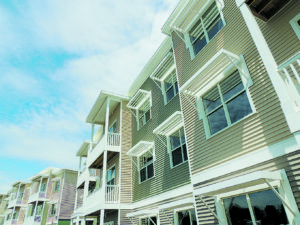Net-zero living is now affordable for the general public!

The south side of the netZero apartment building. Note the awnings that subtly offset some of the solar gain in the summer months, yet still allow light in to keep lighting needs lower. Photos courtesy of Bruns Realty Group
By David Bruns
After a very successful first phase of 72 apartments, completed in September of 2015, netZero Village is completing its second and final phase with 84 more. When completed in September, the $20 million complex located at 994 Burdeck St, in Rotterdam, New York, will include 156 apartments, a clubhouse with exercise facilities and community room, walking trails, athletic field and community gardens. netZero Village is the first large-scale, market-rate, net-zero apartment complex in the United States. The goal of netZero Village is to prove that net-zero, market-rate multifamily development is commercially viable in the northeast, so the message can be spread to other developers.
The EnergyStar-certified development has proven there is a healthy demand for eco-friendly, net-zero living. The first phase of 72 units was leased in three months. The second phase is also leasing at a brisk pace; after only two months, 50 out of the 84 units are leased. The community includes a mix of one-bedroom and two-bedroom apartments, with and without study areas. The apartments range in size from around 800 square feet up to 1100 square feet. The rents range from $1,215 to $1,465 per month, including all utilities, internet, and basic TV.
netZero Village achieves its net-zero goal through highly engineered buildings that use proven, “off-the-shelf” energy-efficiency technologies combined with harvesting the free power of the sun. This is what makes the “all-inclusive” rent cost possible. Residents never have to worry about increasing energy costs and can count on the same rental payment for the duration of each lease.
It is a goal of netZero Village to offer affordable, net-zero living without sacrificing comfort. The architectural firm involved with this project is Harris A. Sanders Architects from Albany, NY. All of the apartments feature luxury amenities, including a full-sized washer and dryer in each unit, built-in microwave, range, dishwasher, covered parking and electric vehicle charging stations, and more. Energy efficient LED lighting is used exclusively throughout the village.
The single-hung vinyl windows were made by Paradigm. The glazing has a U factor of 0.21 and SHGC of 0.64. Exterior doors are fiberglass made by Therma-Tru. The walls have 3.5 inches of closed-cell spray foam on top of Zip Sheathing (R-23). The roof has four inches of polyisocyanurate foam sheet insulation on the deck with 2.5 inches of closed-cell spray foam underneath (R-38). The slab has two inches of expanded polystyrene insulation (R-11). Each apartment has its own Mitsubishi Hyper-Heat mini-split heat pump for heating and cooling. There is single head in each apartment rated at 12,000 BTUs per hour.
Apartments are EPA Indoor Airplus certified, and they are blower-door tested for air leakage of less than 0.6 ACH50. Ventilation is provided by a continuous fresh air exchange from a heat recovery ventilator in each apartment. This, combined with low-VOC materials and hard-surface flooring to minimize dust and allergens, assures superior year-round indoor air quality.
Energy from the sun is harnessed in three ways: (1) by photovoltaic (PV) solar panels that convert sunlight into electricity, (2) by solar thermal panels for domestic hot water, and (3) by the passive solar design of the buildings, so the sunlight heats apartments during the winter.
There are 66 kilowatts of PV panels installed for each 12-unit apartment building. This is more than enough to meet the 56,000 kilowatt hours needed per building annually. They are mounted on solar carports. The solar hot water systems are mounted on the building roofs. They supply over 80% of the hot water needs.
The passive solar design of the buildings generates roughly 50% of the energy needed to heat the buildings. It includes exterior features for summer shading. The passive solar design and nine-foot ceilings make the apartments feel bright and spacious.
For more information about the netZero Village, visit www.netzerovillage.com.
David Bruns is the general manager of Bruns Realty Group.
Many thanks to our sponsor:









Leave a Reply